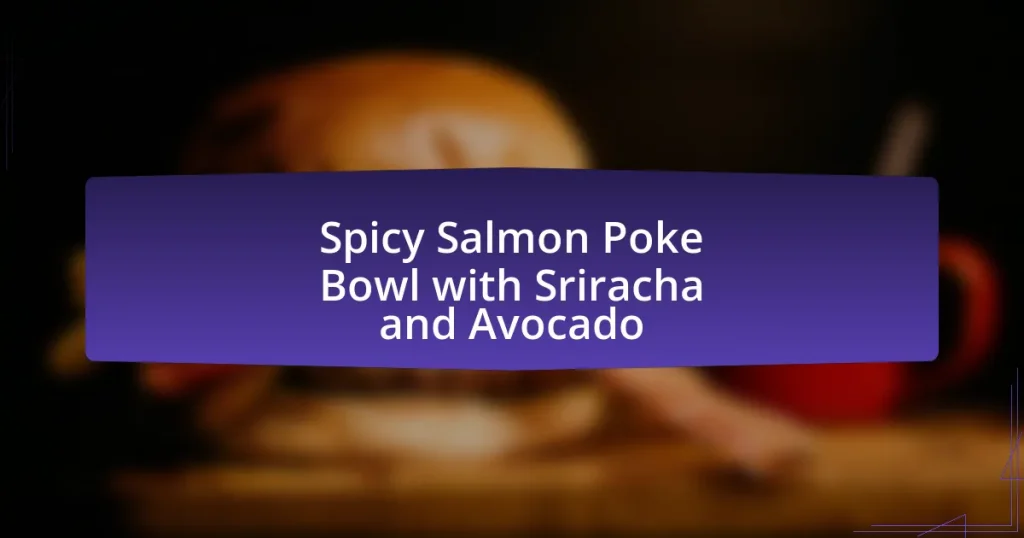Unique poke bowl combinations with exotic ingredients are transforming traditional dishes by incorporating flavors such as mango and jalapeño with tuna, coconut and lime with shrimp, and dragon fruit with salmon. These innovative pairings enhance the taste and visual appeal of poke bowls, moving beyond standard toppings to include diverse ingredients that reflect culinary creativity. The article explores how these unique combinations differ from traditional poke bowls, the importance of exotic ingredients, and emerging trends in the culinary landscape. Additionally, it provides insights into assembling a successful poke bowl, balancing flavors and textures, and ensuring freshness and quality in ingredients.

What are Unique Poke Bowl Combinations with Exotic Ingredients?
Unique poke bowl combinations with exotic ingredients include options like mango and jalapeño with tuna, coconut and lime with shrimp, and dragon fruit with salmon. These combinations enhance traditional poke bowls by introducing flavors that are not commonly used, such as the sweetness of mango paired with the heat of jalapeño, which creates a balanced taste profile. The use of coconut adds a tropical twist, while dragon fruit not only provides a vibrant color but also a subtle sweetness that complements the richness of salmon. These unique pairings reflect a growing trend in culinary creativity, where chefs experiment with diverse ingredients to elevate the poke bowl experience.
How do unique poke bowl combinations differ from traditional ones?
Unique poke bowl combinations differ from traditional ones primarily in their ingredient selection and flavor profiles. Traditional poke bowls typically feature a base of sushi rice topped with raw fish, such as tuna or salmon, and standard toppings like seaweed, green onions, and soy sauce. In contrast, unique poke bowl combinations often incorporate exotic ingredients, such as tropical fruits, unconventional proteins like tofu or octopus, and diverse sauces, including spicy mayo or citrus vinaigrettes. This variation not only enhances the visual appeal but also introduces a broader range of flavors and textures, appealing to adventurous eaters.
What defines a poke bowl as unique?
A poke bowl is defined as unique primarily by its combination of fresh, raw fish, typically marinated, served over a base of rice or salad, and topped with a variety of ingredients that reflect diverse culinary influences. This dish originated in Hawaii and is characterized by its customizable nature, allowing for a wide range of toppings such as seaweed, avocado, and various sauces, which can include traditional Asian flavors like soy sauce or more innovative options like spicy mayo. The uniqueness is further enhanced by the use of exotic ingredients, which can vary regionally and seasonally, making each poke bowl a distinct culinary experience.
Why are exotic ingredients important in poke bowls?
Exotic ingredients are important in poke bowls because they enhance flavor profiles and introduce unique textures that elevate the overall dining experience. The incorporation of ingredients such as mango, seaweed, or wasabi not only adds distinct tastes but also reflects cultural diversity, making the dish more appealing to a broader audience. Additionally, exotic ingredients often provide nutritional benefits; for example, seaweed is rich in vitamins and minerals, contributing to a healthier meal option. This combination of enhanced flavor, texture, and nutritional value underscores the significance of exotic ingredients in creating memorable poke bowl experiences.
What are some popular exotic ingredients used in poke bowls?
Popular exotic ingredients used in poke bowls include seaweed salad, mango, and wasabi peas. Seaweed salad adds a unique umami flavor and is rich in nutrients, while mango provides a sweet contrast and vibrant color. Wasabi peas contribute a spicy crunch, enhancing the overall texture and taste of the dish. These ingredients are commonly chosen for their ability to elevate the traditional poke bowl experience.
How do these ingredients enhance flavor profiles?
Exotic ingredients enhance flavor profiles by introducing unique taste elements and aromatic qualities that elevate the overall dish. For instance, ingredients like yuzu provide a citrusy brightness, while miso adds umami depth, creating a balanced and complex flavor experience. The incorporation of ingredients such as seaweed contributes a briny note, enhancing the freshness of the poke bowl. Additionally, spices like togarashi introduce heat and complexity, further enriching the flavor layers. These enhancements are supported by culinary principles that emphasize the importance of contrasting and complementary flavors in creating a satisfying dish.
What nutritional benefits do exotic ingredients provide?
Exotic ingredients provide a range of nutritional benefits, including enhanced vitamins, minerals, and antioxidants. For instance, ingredients like spirulina are rich in protein and essential amino acids, while dragon fruit offers high levels of vitamin C and fiber. Additionally, many exotic spices, such as turmeric, contain curcumin, which has anti-inflammatory properties. These unique components contribute to improved immune function, digestive health, and overall well-being, making them valuable additions to dishes like poke bowls.
How can unique poke bowl combinations be created?
Unique poke bowl combinations can be created by experimenting with diverse ingredients, flavors, and textures. By incorporating various bases such as sushi rice, quinoa, or mixed greens, and pairing them with proteins like tuna, salmon, or tofu, one can achieve distinct flavor profiles. Adding unique toppings such as seaweed salad, pickled vegetables, or exotic fruits like mango or dragon fruit enhances the overall experience. Additionally, using different sauces, such as spicy mayo, ponzu, or sesame dressing, allows for further customization. This approach not only caters to individual tastes but also encourages creativity in crafting personalized poke bowls.
What are the key components of a successful poke bowl?
A successful poke bowl consists of fresh fish, a base, toppings, and sauces. Fresh fish, such as tuna or salmon, provides the primary protein source, ensuring quality and flavor. The base, typically rice or salad greens, serves as the foundation, offering texture and substance. Toppings like avocado, seaweed, and pickled vegetables add flavor and visual appeal, while sauces, such as soy sauce or spicy mayo, enhance the overall taste profile. Each component contributes to a balanced and satisfying dish, making these elements essential for a successful poke bowl.
How can one balance flavors and textures in a poke bowl?
To balance flavors and textures in a poke bowl, one should combine contrasting elements such as creamy avocado, crunchy vegetables, and tender fish. This approach creates a harmonious experience by integrating different taste profiles, like sweet mango, salty soy sauce, and spicy sriracha, alongside varied textures. For instance, using a base of sushi rice provides a soft foundation, while adding toppings like seaweed salad and pickled ginger introduces crunch and acidity, enhancing the overall dish. This method is supported by culinary principles that emphasize the importance of texture and flavor contrast in creating appealing dishes.
What trends are emerging in the world of poke bowls?
Emerging trends in the world of poke bowls include the incorporation of unique and exotic ingredients, such as jackfruit, quinoa, and various types of seaweed. These ingredients not only enhance the flavor profile but also cater to diverse dietary preferences, including vegan and gluten-free options. The rise of health-conscious eating has led to a demand for poke bowls that feature superfoods like spirulina and chia seeds, which are known for their nutritional benefits. Additionally, fusion flavors, such as spicy tuna with kimchi or mango salsa, are becoming increasingly popular, reflecting a blend of culinary traditions. This trend is supported by consumer interest in innovative dining experiences and the growing popularity of poke as a customizable meal option.
How are chefs innovating with exotic ingredients?
Chefs are innovating with exotic ingredients by incorporating unique flavors and textures into traditional dishes, particularly in poke bowls. For instance, they are using ingredients like dragon fruit, yuzu, and black garlic to enhance the sensory experience of the dish. This approach not only diversifies the flavor profile but also attracts a broader audience seeking novel culinary experiences. Research indicates that the use of exotic ingredients can increase customer interest and satisfaction, as seen in a study published in the Journal of Culinary Science & Technology, which highlights the positive impact of unique ingredient combinations on consumer preferences.
What cultural influences are shaping new poke bowl combinations?
Cultural influences shaping new poke bowl combinations include Asian, Latin American, and Mediterranean cuisines. Asian flavors, such as soy sauce, sesame oil, and pickled vegetables, enhance traditional poke, while Latin American ingredients like mango, avocado, and spicy salsas introduce a fresh twist. Mediterranean elements, including olives, feta cheese, and herbs, further diversify the flavor profiles. These influences reflect a growing trend of fusion cuisine, where chefs experiment with diverse ingredients to create unique and innovative poke bowl offerings.
What are the best practices for assembling a unique poke bowl?
To assemble a unique poke bowl, start by selecting a base that includes a variety of textures and flavors, such as sushi rice, quinoa, or mixed greens. Next, choose a protein, like fresh tuna, salmon, or tofu, ensuring it is high-quality and sustainably sourced. Incorporate a mix of colorful vegetables, such as radishes, seaweed, or avocado, to enhance both visual appeal and nutritional value. Add unique toppings like furikake, sesame seeds, or pickled ginger for additional flavor complexity. Finally, drizzle a distinctive sauce, such as spicy mayo or ponzu, to tie all elements together. These practices ensure a balanced, flavorful, and visually appealing poke bowl, aligning with culinary trends that emphasize freshness and creativity.
How can one ensure freshness and quality in ingredients?
To ensure freshness and quality in ingredients, one should source them from reputable suppliers who prioritize sustainable practices and proper handling. Fresh ingredients are typically harvested at their peak ripeness, which enhances flavor and nutritional value. For example, seafood should be purchased from suppliers who adhere to strict guidelines for freshness, such as the Marine Stewardship Council certification, which ensures sustainable fishing practices. Additionally, storing ingredients at appropriate temperatures and using them within their optimal shelf life further maintains their quality. Regularly inspecting ingredients for signs of spoilage, such as discoloration or off-odors, also helps in ensuring that only the best quality ingredients are used in dishes.
What tips can help in achieving visual appeal in poke bowls?
To achieve visual appeal in poke bowls, focus on color contrast, texture variety, and strategic placement of ingredients. Using vibrant ingredients like bright vegetables, colorful fish, and garnishes creates an eye-catching presentation. For example, incorporating ingredients such as avocado, radishes, and seaweed not only enhances color but also adds different textures, making the bowl more visually interesting. Arranging the components in a circular pattern or in sections can create a more organized and appealing look. Studies in food presentation indicate that visually appealing meals can enhance the dining experience, making it more enjoyable and memorable.
How can one experiment with unique poke bowl combinations at home?
To experiment with unique poke bowl combinations at home, one can start by selecting a base, such as sushi rice, quinoa, or mixed greens, and then layer it with various proteins like marinated tuna, salmon, or tofu. Next, adding a variety of toppings, including seaweed salad, pickled vegetables, and fresh fruits like mango or avocado, enhances flavor and texture. Finally, drizzling different sauces, such as spicy mayo, soy sauce, or ponzu, can elevate the dish. This approach allows for endless customization, enabling individuals to create unique combinations tailored to their taste preferences.



